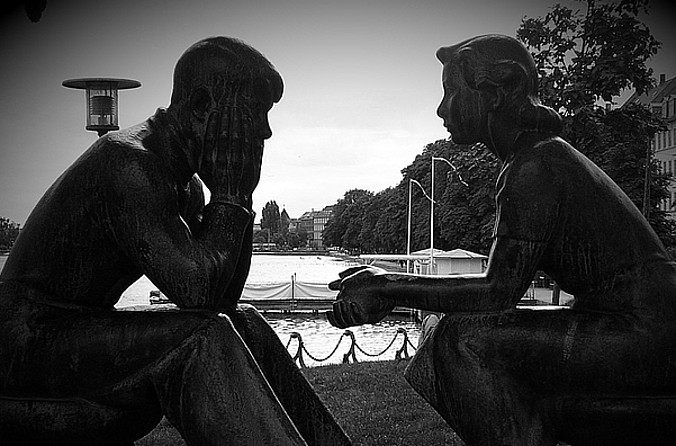The book Ways of Seeing, written by John Berger with the cooperation of Sven Blomberg, Chris Fox, Michael Dibb and Richard Hollis, was first published in 1972. It is based on the BBC Television Series (watch it at the end of this article) on the same title. The book Ways of Seeing is a very penetrating and provocative look at the interpretation of traditional painting as well as modern day publicity. The authors are trying to find the answer not only to how we speak, but also to how we understand the meaning of what we are trying to say through painting and modern advertising. The book contains seven chapters which can be read in any order. They offer illustrative pictures as supporting examples for their arguments. Three chapters of seven contain only pictures showing the manner in which woman are interpreted in paintings. Berger is trying to start in the reader “a process of questioning.” Many ideas in Ways of Seeing come from the book The Work of Art in the Age of Mechanical Reproduction written in 1935 by German cultural critic and philosopher Walter Benjamin.
Ways of Seeing discusses how people have looked on the arts in the past and how they look on them in our present time and the relationship between these two viewpoints. A key interest of Berger’s is in the relationship between social status and the subject of a painting. The role of the female nude is a major theme of his work. The role of image in modern publicity is as important to the author as the interpretation of the oil paintings of the past. Ways of Seeing also deals with images, photographs, paintings and drawings and their relation to the world of text.
Berger at the outset says that “the way we see things is affected by what we know or what we believe.” (p. 8) Human life is almost affected by past and present experience, or even future ideas in human mind. There is a communal aspect to this as well because people’s share their lives and their ideas with others because human life is not an “isolated island.”
The author of Ways of Seeing tries to explain different views of art from the fourteenth century until the present time. The author explores the tension between word and image. Words are being superseded images today. This tension is expressed by Neil Postman who said in How to Watch TV News, that “a picture is worth a thousand words. Maybe so. But it is probably equally true that one word is worth a thousand pictures, at least sometimes – for example, when it comes to understanding the world we live in.”[1] In today’s media language, however, the word is being exchanged for images. In others way, the image can be supported by word, sometimes giving the image much more power.
Berger said that people are determined by everything that they know and they believe in. We are politically and historically conditioned as to how we see things. For example, the image of hell has been seen differently in every century.
Artists-painters have made a great contribution to our understanding by their desire to create a device which would be able “to stop the world on the moment”. Their experiments in this effort reflect different levels of consciousness. Thanks to the different techniques they have explored, we can establish different ways of seeing. Artists have tried to fix the meaning of beauty, truth, genius, civilization, form, status, taste, etc. Every image possesses a certain composition and specific symbolic meaning which will anchor it in its own time and help define its epoch.
Painters carry huge emotional content into their work. We can see this clearly in their paintings. We can recognize the character of the persons we see from their motions, faces, gesture, etc. These images help define our knowledge about a given culture in its particular time. Even though the pictures remain the same, the form of our perception changes over the years. Today, “we see the art of the past as nobody saw it before. We actually perceive it in a different way.” (p.16) All of this is affected by the convention of perspective which developed uniquely in Europe and assumed a shape in early Renaissance.
The image, captured from reality of its present time, will always be viewed as a moment of the past. The event pictured already having happened, the event is already behind us. Even if the image were to be only a second before, that second is already the past. The camera always will represent and show us only the past but, since it represents the past as present, the image is will always contain a tension of past and present. The photo’s creator will always be on one side of the event pictured – giving the one watching the pictures or drawings a sense that he has shared this unique viewpoint on the pictured event, a unique standpoint towards the world at that moment. The widespread use of photography adds an addition element to this question of viewpoint because the “painting now travels to the spectator rather than spectator to the painting. In its travels, its meaning is diversified.” (p. 20) Now, we are more likely to buy a reproduction of the Virgin of the Rocks by Leonardo da Vinci than go to see the real painting. This complicates the interaction of the viewer and the painting by adding market value and cost to the basic artistic question of beauty and genius that are posed by seeing the painting in its original setting.
Reproductions can be used personally, politically or commercially. If we hang numerous small pictures in our house, we can create a small domestic museum for ourselves. The invention of the camera changed the way people experience oil painting. Before, for example in the “early Renaissance church and chapel one has the feeling that the images on the wall are record of the building’s interior life, that together they make up the building’s memory – so much are they part of the particularity of the building.” (p. 19) People more or less lost the direct contact with the context of paintings when the originals were exchanged in public understanding by printed pictures or postcards.
This provokes the author’s questions concerning interpretation of art. Does the absence of any formal education in painting make people ignorant or more perceptive as “innocent and clean mind receiver?” Does lack of artistic education eliminate prejudices or increase ignorance of the world of images? This raises questions of authority. Who decides the meaning and value of art? Do the people who have reproductions of art in their homes establish the norms or trained professional art specialists? We use the language of pictures and images to communicate with each other because they are easy to use. The question remain open: “Who is creator of this language, and why it’s created? How and why it is used?” Language and arts have enormous power to manipulate people’s lives and perhaps to contribute to the destruction of artistic intention and meaning.
The relation between men and woman as social relationship in human life has always been a part of painting and art. Painters work from life. They draw things and people and female nudes has always been a favorite subject for painters. Assuming most artists in history to have been men, woman is always presented as an exterior object to the man as a viewer. Berger said that “men act and woman appear. Men look at woman. Women watch themselves being looked at. This determines not only most relations between men and women but also the relation of women to themselves.” (p. 47)
Berger reminds us of fundamental differences between men and women, women – according to Berger – having a more spontaneous tendency to live in the “world of people”; and men having a spontaneous predisposition to live in the “world of things”. Women are more oriented to words, people and interpersonal relations. Men are oriented to the world of things. For women, everything is important: body, words, emotions, communication, and styles of expression, because they are open to having a contact with other people. In the man’s world, everything is connected by things. In this framework, women become known objects being viewed. Women are constantly seen in relation to being watched by men and this affects their view of themselves.
Berger said that: “The woman is not naked as she is. She is naked as the spectator sees her.” (p. 50) Women were constantly used as a “muse” in man’s oil paintings. These images of women were viewed not only by a male painter, but of course by women as well and this male-oriented view of a woman then influences a woman’s view of herself. Berger creates a distinction between being naked and nude. To be naked means to be without any clothes, but without being viewed as an object by anyone. To be nude means to be viewed as sexual object or for a pleasure. A woman may think that a nude picture of herself is about her as a person who is observed by someone, but the truth is the nude picture of her actually may say more about the painter than the model. Such a painting is ultimately about what the man sees. If the painter is a man, then the final work is always the man’s statement about his point of view about the woman who is naked. One symbol frequently used in painting female nudes is the mirror which represents female vanity the, the essence of which is a woman viewing herself. But, in fact, the painting is about the male viewer, not the female self-image. In Berger’s opinion, only very few painters can express the truth of a woman’s nakedness.
Painters in numerous attempts (more or less successful) capture for the receiver on the canvas, what they see. They want to express on wooden frames the living reality which they saw, experienced, and recognized. With the brush they “drew the state of their own soul” which moved with their inspiration, showed their reality which included much that was for many invisible and inaccessible. They opened the door to dark elements in looking into what happened around them. In images they showed buildings, castles, and battles; animals as a proof of value, landscapes and more. Most importantly however they always showed man, who was shown as “the creator of this world.” Things around him are shown as a part of his possessions as a symbol of his pride, fortune, wealth, prestige and power.
Also on the side of darkness, there is the symbolic role of the skull as a thing situated by the painter in his paintings to remind people about their death (Memento Mori), and perhaps the lasting values in life. Using metaphysical symbols painters remind their viewers about a “sense of the question of existence, of existence as a question.” (p. 112) Berger describes two of Rembrandt’s self portraits as examples. The first one was painted in 1634 showing Rembrandt, when he was 28 years old, with his new wife Saskia, as a very happy couple. This can be seen as a prototype for many advertisements showing how the “real” happy, fortunate, prestigious life should look. The second portrait is different. Painted 30 years after the first one, it shows Rembrandt as an old man. This portrait eliminates any questions about the real cost and nature of living a life.
Advertising influences human thinking. The first rule that was incorporated into the advertising technique relates to various kinds of needs people developed due to cultural factors and to hidden desires embedded in culture. The second principle is to create irrational, i.e. incomprehensible or senseless desires and needs. Advertising has as a goal the creation of unjustifiable fondness towards a given product, which as a matter of fact, was not better than the other analogous products of different companies. Therefore, the point is to create a feeling in the recipient’s mind that one product is better than the others. Berger says that “the purpose of publicity is to make the spectator marginally dissatisfied with his present way of life. Not with the way of life of society, but his own within it. It suggests that if he buys what is offering, his life will become better.” (142) In this effort, a very important role can be attributed to visual symbols. Everything must be designed according to a very specific scheme – to present an object in such a way that the public should feel fondness towards this product and buy it. As time went by, advertisements developed another level of creating images. Not only was the product pictured attractively. But potential buyers themselves are presented in the advertisement in an idealized form, in compliance with their dreams as people who are happy with their life, cheerful, rich, without problems. This concept plays the emotions of envy and glamour creating a self-image for the potential consumer as happier than others who do not possess the item to be sold.
Advertisements, using such images and bombarding the public with them constantly day by day, are not restricted only to persuading the public effectively about the perfection of a given product. “Women are buying a promise – said one of the executives of the advertising agency in Milwaukee. – The cosmetic manufacturers are not selling lanolin, they are selling hope (…) We no longer buy oranges, we buy vitality. We do not buy just an auto, we buy prestige.”[2]
Advertising uses these mechanisms to its own benefit to make the potential customer notice the existence of a given product or service. Advertising substitutes its own commercial concerns above moral principles, using the corrupting influences of envy, glamour, greed, and unhealthy competition. Berger said glamour is used to show off the materialistic goods to create envy in the people who do not have such goods – making envy a key of today advertising. The desire is to make people feel uncomfortable without the presented things and finally decide to posses the offered products. Inseparable elements of this kind of advertising are woman and sex. Berger keeps coming back to the idea from the beginning of his book, that men still want woman and sex and woman, in this context, are deprived of self worth and seen as an object adored by man. The female nude is used now in advertising as it was used in traditional oil paintings of the fifteenth century.
John Berger’s Ways of Seeing is a very “open minded” art book used as a textbook in courses of art history at American universities. It is a helpful, searching book, looking for an understanding into present ways of seeing; questioning our present visual culture. The history of the great masters of painting from the fifteenth century is also explored as well as modern advertising art used by many companies to make profits since art and photography are both a big part of today’s business and materialistic style of life. Both painting and advertising are potential tools for shaping and changing our sense of life’s truths and Ways of Seeing explores the power and effect of these tools on our lives.
—————————-
[1] Postman, N., Powers S. (1992). How to Watch TV News. Penguin Groups, London, p. 104.[2] Fuksiewicz, J. (1973). Anatomia telewizji w USA (The Anatomy of Television in the USA), Atlas Press, Warsaw, Poland, p. 76.










